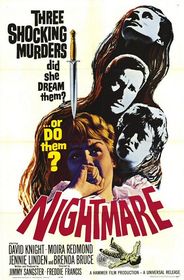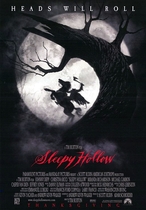Our editor-in-chief Nate Yapp is proud to have contributed to the new book Hidden Horror: A Celebration of 101 Underrated and Overlooked Fright Flicks, edited by Aaron Christensen. Another contributors include Anthony Timpone, B.J. Colangelo, Dave Alexander, Classic-Horror.com's own Robert C. Ring and John W. Bowen. Pick up a copy today from Amazon.com!
Nightmare (1964)
I've argued in the past that Hammer Films can only seem to make an excellent horror movie when at least one of the Trifecta of Hammer Horror is involved: Christopher Lee, Peter Cushing, or Terence Fisher. They’ve made adequate films, even good films, without the trifecta, but only the trifecta is capable of making the masterpieces.
Apparently, I have lied to you people.
Nightmare, despite the absence of any member of the Hammer Trifecta, is a Hammer masterpiece. From the chilling beginning to the surprising conclusion, this film sets the bar for British suspense. Sharp, haunting, and absolutely timeless, Nightmare should already be on your video shelf.
Janet is a young girl at boarding school who has a very bleak history. When she was a little girl, she saw her mother stab her father to death. She is haunted by the visions of this day until she can barely function. When the school decides to put her under observation of a doctor at her own house, the visions get worse until Janet does not know if there are supernatural forces at work or she is trapped within her own madness.
Right off the bat, the film opens with one of the darkest sequences ever in Hammer. The mood music begins and we are walking down a dark and secluded hallway. We believe that what is about to happen is real as we have no reason to think otherwise. Slowly we turn the corner and we discover that we are in the cell of a mental home with a crazy lady standing in the corner. She turns slowly with an evil smile and says, “You know you are as mad as I am.” And as she comes at us, only then do we wake up and realize it was just a dream. A strong opening scene is the first step toward a Hammer masterpiece. Most lesser Hammer films fall into the ever-too-convenient trap of developing characters without getting us interested in the story first, a technique that tends to lose less patient viewers. Not so with Nightmare. After the opening sequence, you are stuck for the entire 90-minute ride.
And the ride is completely unrelenting – director Freddie Francis makes sure of that by developing the character of Janet extremely well. Immediately he makes sure we sympathize with Janet’s madness despite the fact we do not know its origin yet. The catch that keeps our attention is this very sympathy. We care for Janet, we want to know her backstory, and we want to know if she will get better. In the second act of the movie, Janet is pushed out of the spotlight in lieu of deeper plot points. This could have been a catastrophe and with a lesser movie it would have been. Ordinarily, it’s not all that great of an idea to build up so much hype for the main character only to shove her out of the way in the second half. However Francis made it work by gradually shifting our attention elsewhere. Long before Janet becomes absent, we smell a conspiracy burning, so when that becomes the focus of the story, we don’t even notice Janet is gone. It’s the “here, look at the birdie” of filmmaking. With every little plot revelation, we just become more and more enthralled with the story, while commenting “damn… I didn’t see that coming.”
Going with the “here, look at the birdie” theme, Francis distracts us with some very eerie visuals. For most of the movie, we have no idea whether Janet’s images are real, ghosts, or some conspiracy from those around her trying to make her go mad. To keep us confused, Francis had the difficult task of making any ghostly image also seem real. The one of note comes toward the end when we see a girl in a long white dress walking across the screen. With a couple nice lighting tricks and pacing the movement “just so,” the audience can believe at the same time that 1) the blond-haired lady is a ghost, and 2) the blond-haired lady is not a ghost. Convincing the audience to believe two conflicting thoughts is practically impossible, but Francis does it effortlessly. Not to mention, by keeping us always second guessing ourselves, it's damn near impossible to guess the ending even for the most seasoned or jaded horror movie fan.
Nightmare is surely the sleeper hit of the Hammer community, as at first glance it looks like another disposable rip-off of Psycho (not to mention this film was originally released under the title Here's the Knife, Dear: Now Use It which didn’t do a whole lot for it’s credibility either, I’m thinking). In reality, comparing it to Psycho is both misleading and a disservice. Psycho took a relatively simple story and made it extraordinary through barrier-breaking direction. It can hardly be argued that without Hitchcock behind the camera, Psycho would be nearly as influential as it was. This does not seem to be the case for Nightmare, as Nightmare’s strength comes from the script itself. We don't see writing this convoluted and engaging often in Hammer. In fact, it goes so against the Hammer formula that I was actually quite shocked that it was written by veteran Hammer scriptmaster, Jimmy Sangster (Curse of Frankenstein, Horror of Dracula). This script really shows Sangster’s diversity as a writer. In fact, I dare say this was his best script ever, which is saying something given his track record with writing other Hammer masterpieces. In fact, Sangster is so influential in the world of Hammer, he almost deserves to be put into Hammer trifecta, but then it would be the quadfecta which just sounds stupid. Plus he wrote Paranoiac, so hell with him.
Nightmare, despite all evidence to the contrary, ends up being one of Hammer’s most well-crafted and influential films. It is one of the few horror films that have actually surprised me and kept me guessing right up until the end. I highly recommend it for all fans of classic horror and people of good suspense. Pick it up on a rainy weekend when the wolf bain is in bloom. You’ll wonder what took you so long to do so.









"...this film was originally
"...this film was originally released under the title Here's the Knife, Dear: Now Use It "
NO, it wasn't, not in the U.S.A. anyway:
It went out as "Nightmare", supporting "Evil Of Frankenstein" , double-feature for Universal 1964.
I saw them together in New Haven, Conn. back then---"Evil" was blah, "Nightmare" the winner---F. Francis best along with "The Skull" ['65]. "Psycho" way over-rated---"Homicidal" ['61] and "The Strangler" ['64] and "The Psychopath"['65] delivered a better punch in their initial theatrical release. Anthony Perkins in that dress & wig: this is horror ? Not for the teenagers we were then---we laughed our jaws off.
Hm. Looks like Here's the
Hm. Looks like Here's the Knife Dear, Now Use It may actually be a UK re-release title of some sort. I'll do some more digging and update the information in the review as needed.
"He went for a little walk! You should have seen his face!"
NOT in England either: It
NOT in England either: It played there as "Nightmare" also.
London Postcards Hammer Collection are *here*:
http://www.britposters.com/Wishlist.htm
NIGHTMARE UK poster *here*:
http://www.britposters.com/wishimages/nightmare.jpg
Cheers !
I'm not disputing that the
I'm not disputing that the original release title of the film was Nightmare, contrary to what the review says. I just did some research and it appears that Here's the Knife... was a working title that was probably never used in release (this from the American Film Institute's Catalog of Motion Pictures). Once I've confirmed this with another source, I'll update the review.
"He went for a little walk! You should have seen his face!"